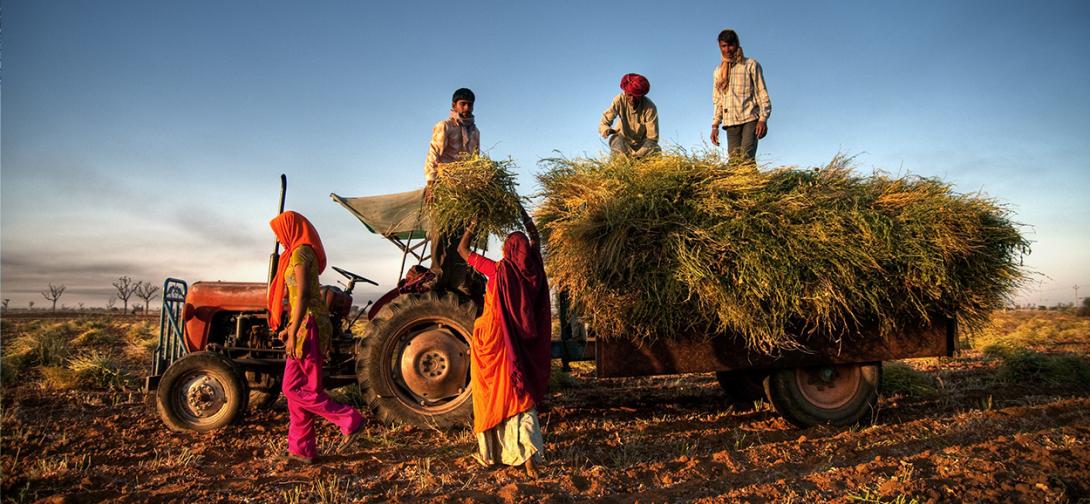Strengthening the Indian Agriculture ecosystem
India is growing at a rapid pace and so is the use of technology in the growing sectors of the country. A major mass of the population is still dependent and practicing agriculture as its primary source of income. India has been in a continuous tryst with its farming infra, practices and associated communities since independence. With the sector still contributing around 15-20% to the national GDP of the country over few decades, and its diverse cum changing needs across its regions, India has been driving necessary and timely interventions at Industry, Institution, and individual farmer level for its constant manifestation. As agriculture is a sector that emotionally appeals to the masses, Indian agencies were prompted to undertake policy measures to stimulate industry landscape by improving access to credit and widening scope of crop insurance. Setting up and enabling institutions to mobilize essential Agri services and new age technology production inputs further, empowering individual farmers through incentives like subsidies on input resources across the farming value chain and enhancing their social security conditions.
Measures or interventions to cater to the larger farming community is of utmost necessity given the diverse needs of farming in India. As one positive amendment of the existing policy or introduction of fresh clauses to benefit the growing aspirations or expectations of any farmer, may hamper farm’s productivity in the longer run. For instance, increased subsidy on chemical fertilizer purchases by the farmer groups may deteriorate the soil health in the long run which as well, worsens the cash flow a farmer may have to budget y-o-y. In this direction, introduced technology-driven aids like the soil testing centers across the country have made a considerable impact on the farmer’s choice of crop, cropping pattern, level of mechanization and irrigation solutions.
Farming in India is plagued by Micro land holdings that also limit any farmer’s scope and scale to adopt mixed farming or shift to growing multiple crops simultaneously or even take up innovative approaches to grow a crop. In recent years, the Government has been proactive in designing the right platform and rolled out necessary measures to reduce the burden of informal setup in agri and allied services. One such effort has been encouraging Farmer Producer Organisations across the country, which has encouraged and benefited the farming community at large.
Farmer Producer Organization are established under the statute of companies Act or the State Co-operative Act. As an organization, it follows a very unique model of collective and crowdsourced efforts from like-minded farmers belonging to a particular region or growing common crops. Although FPOs were envisaged for better marketing practice by a group of farmers, over the years they have proven to positively impact all the players and practices of the farming value chain. Meanwhile, through this mode of BAU, farmers are in a better position to tackle price uncertainty, improve processing and storage capacities, experiment and deploy newer farming methods at large also, improved access to formal sources of credit. FPOs have resulted in farmers identifying inherent sectoral risks in the farming ecosystem and initiating collective action to mitigate them.
a. Source: http://sfacindia.com/
The growth in number of FPOs in the country is a testament of a farmer’s choice towards newer and efficient production systems. Supporting this, the Government of India has also announced a goal of incorporating 10000 FPOs by 2023, which can cater to the larger farmer community and land area as well. In the same direction, state governments have also proposed a dedicated state legislation to establish and regulate State FPOs in the near future, thus adding more impetus. States like Madhya Pradesh, Maharashtra and Karnataka already having lions’ share in terms of the number of FPOs and number of farmers impacted have already proposed to set up and support FPOs specific to crops grown by state farming communities.
In addition to the above, crop or region-specific clusters formed across the country along with, CBBOs [Cluster Based Business Organizations] will further better the collective efforts. As their establishment is intended to bring professional expertise and technical resources closer to the FPO. This will necessarily weed out unnecessary delay in availing critical inputs and decision-making at the farmer’s end.
Digital resources at farmer’s disposal not only lead to the efficient utilization of capacity but also has the scope to improve processes on the field. This approach will thus lead to effective utilization of the available resources and add immense value to the agricultural value chain. With high risks that are involved due to lower yield as a result of marginal sizes of farmland, inadequate irrigation facilities coupled with expensive informal farm liabilities, farmers in India have had to face uncertain times. This gap identification and a concentrated effort to solve them has been a focus of the governments of the past as well as of the present.
To improve the technological rigour and resilience of the sector, a fair share of rapid mechanization activities and farmer incentivizing measures are being carried out. Recent changes made in Pradhan Mantri Fasal Bima Yojana, to expand the ambit of crop insurance by adding more crops under scheme coverage as well as, mandating of crop insurance for Agri loans, intercedes with the vision of a stronger farmer community practice.
Susceptibility of agriculture to natural disasters like drought, floods, cyclone, storm, landslide, earthquake etc is a very well-known phenomenon but, epidemic and pandemic in recent times have compounded the negative effects on the produce and farmer income. As no exception man-made fiasco like fire, sale of spurious seeds, excessive use of fertilizers and pesticides and price crashes have also been equally responsible for limiting the farming sector all over the world. Due to the market inefficiencies like asymmetry of information, moral hazard and adverse selection prevalent in the Indian agri ecosystem, crop insurance has still been a laggard. This does have spillover effects into other decision-making processes of a farmer, that could result in indecisiveness to adopt new age methods of farming or seek institutional support.
Thus, mechanisation of farms is an approach which has provided great benefits to farmers across the world and the same will be true for India. Over the years, Government has initiated numerous measures towards farm mechanisation that has led to certain improvements in outputs and welfare conditions. Umang and Mkisan applications have also accelerated the reach of critical information to the farming communities. Platforms like these have also assisted farmers in availing Government provided benefits, subscription to seed-fertilizer-credit subsidies and other important information. But to achieve exponential growth in farm output a concerted effort involving the entire ecosystem is very necessary and, in this direction, the sector has seen the entry of entrepreneurs in the agriculture ecosystem.
The service-based models developed by the entrepreneurs have enabled farmers to increase their productivity, overcome few weak points in consultation with entrepreneurs. This has also given a boost to the incomes of the farmers leading to an improvement in their socio-economic conditions. These disruptive models that are changing the landscape of the farmers’ ecosystem have been well recognised by the government and have also necessitated amendments in the farming policies from time-to-time. In current times, startups have penetrated throughout the farming value chain from sourcing quality seeds to providing mechanized tools for farming, logistics support for movement of crops and improving access to new markets. In the recent years, with application of new age technologies like blockchain and AI in the farming ecosystem, entrepreneurs have been able to provide farmers with advanced and futuristic solutions to improve their output. Usage of such advanced technologies have also provided the startups with new funding opportunities as they are now trying to concentrate and solve the major challenges that the farmers community will face due to climatic changes.
Climate change has negatively influenced farming activities characterized by early or delayed rains, lower than average crop cycle and increase in temperatures. Need to protect our farmers against the adverse effects of climate change has been a pressing challenge across countries. Government as well as private crop insurers have been able to develop the necessary insurance framework which will help the farmers if they are to face the brunt of a natural or a man-made disaster. With diverse crop insurance products in the market, an aggressive sensitization campaign to inform the need and type of insurance suitable to a particular farming community, depending on the crop type or region would be highly suitable to overcome information asymmetry. A fair amount of workforce, budgetary and technology allocation by both the state and private agencies in this direction would bolster the crop insurance practice in the country. By the end of 2018, India had already joined the group of top five countries in terms of crop insurance market and technology platforms or solutions are the panacea to address lower rate of subscription to farmer benefits.
1. Agri Credit in India, Source: RBI
One of the important factors that leads to the growth in any sector is the ease of access to credit and the related operational policies that would drive the entire value chain. There has been an undisputable shift in accessing agri credit from non-institutional sources to formal institutions in current times, vis-a-vis pre-2000 levels. The consideration of agricultural loan as a priority sector lending was in itself a transformational step. This alone has made a lot of impact on the entire lending outreach and new age approaches with specific cum exclusive interventions at institutional level will improve the access even more. Also, a wider propagation and sensitization on the usage of the Kisan credit card scheme can go a long way in providing easier credit access to the farmers.
Concurrently, Government of India announced the Pradhan Mantri Kisan Maandhan Yojana that has been received very well by the farming community in the country. With a very basic monthly contribution, farmers upto to the age of 40 can create a retirement corpus for themselves. A subscriber strength of around 21 lakhs since its announcement in 2019, this has amassed a lot of interest, due to its positive outcome. Thus, a mechanism is established to guarantee social security for farmers in the country.
With a strong 46% of the working population employed in Agri and allied sectors, policy thrust to establish institutions and strengthen market linkages will go a long way in improving farmer welfare in the country. As setting up of FPO infrastructure across the country has gained pace in the recent times and are located closer to the farming communities across the nation thereby, minimizing the problem of access to farming services and products. Agriculture credit, Crop insurance, technology inputs and marketing support can be driven in a collective way from these FPO centers. FPOs in association with tech startups can pilot necessary farming interventions and deliver exceptional results and thereby, benefitting the farming community at large. It would be highly imperative if these measures are followed by a robust monitoring framework that can mitigate risks at different levels of the farming ecosystem in India. With recent efforts in expanding agricultural credit, deepened scope of crop insurance and creation of a social security mechanism dedicated to farmers alone, the farming community will be strengthened with policy level measures that may improve their financial wellbeing.
Manglesh R. Yadav is Program Director, NITI Aayog and Shashank Gore is Innovation Lead, AIM NITI Aayog.
Views expressed are personal.
 National Portal Of India
National Portal Of India 







